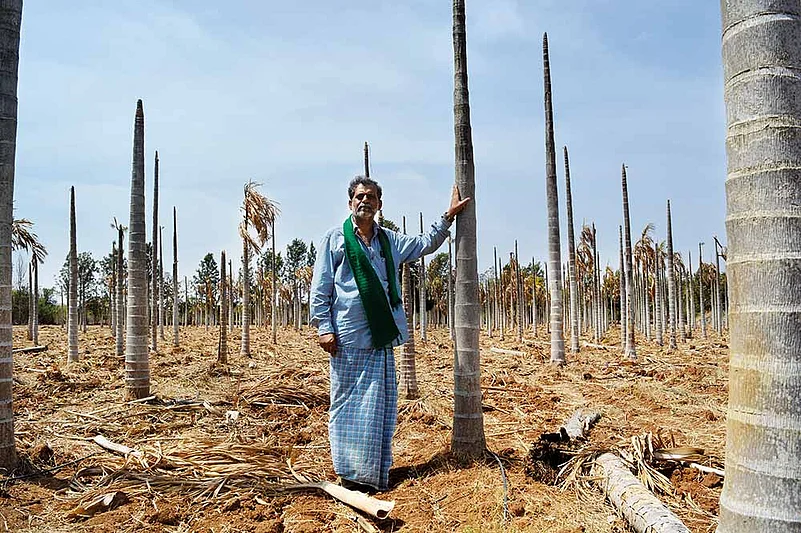It rained last Tuesday in Challakere. But that only helped to settle the dust and the loose, crumbly earth. Ask anyone in these arid parts and you’ll get the same response. “We need a few more showers. The tanks have to fill up.” They haven’t, for a long while.
That brief overnight spell brought hope; a cloudy and a rain-laden, breezy start to the day. By 10 am, however, the sky was clear. Past Challakere, as the sun beat down, villagers drove their cattle into a goshala, as they have been doing every day for the past couple of months. The district administration has set up six goshalas in Chitradurga district—one of the driest regions of Karnataka—where cattle get free fodder. For cattle herders close by, it’s a day-care centre—they collect their ration of 5 kg of hay per cattle head, water their stock from the borewell and settle down in the shade for the day until sundown, when they head back home. But there are others who have trudged here from miles afar and cannot make the trip every day. These folks stay put at the goshala for weeks—among them elderly women who have to rough it out in the open. Family members bring them food at mealtimes, or they cook. “If it weren’t for this goshala,” says Sannaboraiah, a villager, “you can imagine the number of cattle that would have been sold off by now.” Those who were able to scratch together a haystack from a previous crop manage by themselves, but others have no choice but to save their livestock thus. “You should have seen the crowd two years ago,” says another cattle herder. There were close to 5,000 heads of cattle spilling out beyond the fence along the roadside, he recalls, some coming from the Andhra border more than 30 km away. The camp had stretched on for months. At the moment, there are a few hundred head of cattle. “They’ll come,” he predicts. “It’s only the start of May. It all depends on the rain.”
Water dominates existence in Chitradurga—the main issue, the most ardent wish, the muse one tries to appease. It’s a drought-prone district, but years of failed rains are taking their toll. Not far from the goshala, Shivanna and Devramma sit under a thatched awning on their piece of land, staring into the dry, flaky heat. They have a few heads of cattle, goats, some fowl and a stock of hay that will last them a couple of months. But they are careful with the borewell, using it only for the livestock. In January, the couple grew a crop of ragi which will feed the family for a while. Since then, they have been spending every day under the awning, tending to the cattle. A decade ago, Shivanna recalls, there was no time for idling. Someone would offer work on their farms. “This year there has been no work. Evaga bore nalli neeru illandre kariyoru yaaru swamy?” (If there’s no water in the borewells, who’s going to offer work?). Scores of borewells in the region have dried up, people say. Towards the end of April, the district authorities were supplying water in tankers to 132 villages in Chitradurga, making over 500 trips a day. In many villages, the government’s RO water plant booths are the lifeline for drinking water.
“It must be easier to live in a city,” ruminates Devramma, who’s in her late thirties. Several people from her village, too, have migrated to Bangalore, 200 km to the southeast, in search of jobs—in garment factories, as security guards or at construction sites. She has never been there but hazards an opinion. “Still, think of the population in Bangalore.” She is right. Summer is peaking, and Bangalore—academics direly warn about the continuing viability of its creaking infrastructure—is bracing for its annual water scarcity.
Nearly half the country is “in the grip of drought”, a study by the Indian Institute of Technology, Gandhinagar, grimly declared a few weeks ago. Naturally, the burden on depleting groundwater resources will only increase, it pointed out.
Karnataka is very much in the eye of this moistureless state of being. Only in four out of the last 18 years has the state not declared a drought, says G.S. Srinivasa Reddy, director, the Karnataka State Natural Disaster Monitoring Centre (KSNDMC). “During 2015-16 and 2016-17 especially, we declared drought in both the rainy seasons—southwest and northeast.” It was the same last year, but for a peculiarity. In August 2018, the state declared 45 taluks flood-affected. “At the same time, at the end of the season, we declared 100 taluks drought-affected. So, in the southwest monsoon itself, we had both flood in some areas and drought in others,” says Reddy. In the rabi season (winter months), 156 taluks were affected by drought.
“Even if you dig a thousand feet you won’t get any water,” says K.P. Bhoothaiah, a farmer leader from Karnataka Rajya Raitha Sangha at Challakere. Chitradurga, he points out, is an entirely rain-fed district, relying only on one reservoir, the 118-year-old Vanivilas Sagar. Borewells have been sunk by the hundreds over the years but a great number apparently have failed. A villager at the goshala in Doddaularthi recounts how he had sunk a borewell about 18 years ago and struck water at 170 feet; it’s dried up now. “The source was good then,” he says. The last good crop he harvested, he says, was about eight years ago. “If we harvest around 30-40 sacks for every quintal of seed, that’s good.” It costs Rs 10,000 for a quintal of groundnut seeds, apart from the cost of manure, DAP and tractor rental, explains Bhoothaiah. “All this investment and no crop?” he nods in wonderment. Of course, you do come across the rare green patch of a shenga (groundnut) crop which means somebody is lucky enough to have a water source to keep the plants going for the four weeks until harvest.

A woman bears the load of a potful of precious water in Challakere, in Chitradurga district.
Elsewhere in Chitradurga, the desperation is even more stark, especially in the region abutting the rain-lavished Malnad parts. Many farmers here emulate their Malnad counterparts and raise arecanut plantations. But it’s not advisable to grow arecanut here, says farmer leader Echaghatta Siddaveerappa. “But what can you do? People will still grow it,” he shrugs. Siddaveerappa has raised fruit trees on his farm. The blame must go to policies too, he reckons. Farmers have forgotten about local, endemic crops and since the government assures foodgrain distribution, they look at other options, he says.
Arecanut, points out Siddaveerappa, is easier to grow. Except for a large upfront investment, it doesn’t require much labour, compared to foodcrops, while returns are high. But many have burnt their fingers here. Siddaveerappa points to a farm near his home where arecanut fronds have withered, leaving headless trunks. The owner, he explains, raised the grove about seven years ago and invested in a drip irrigation system. It’s about time for his first harvest but most of the trees have withered. At stake is his investment of a few lakh rupees. He had sunk 10 borewells on his four acres, but all have failed. Until recently, the farmer was ferrying water by tractor to water his trees but, beaten by the elements, finally gave up. He’ll probably switch to mekke jola (a variety of maize) this monsoon, says Siddaveerappa.
Others are still making a frantic effort to save their trees. A line of tractor-tankers have queued up outside a borewell along a highway 20 km southwest of Chitradurga town and farmers wait their turn to fill up. “We have been doing this every day, spending a few thousand rupees,” says one of them. Typically, it costs Rs 350 for a tanker of water and about Rs 500 to hire the tractor. Farmers say they are mostly running on borrowed money. “What money can we make growing mekke jola? asks a farmer. “We’ll be left with about Rs 10,000 after taking away expenses.” Arecanut prices, meanwhile, are currently at Rs 36,500 per quintal—a king’s ransom worth its while. Yet, every day, the risk mounts past what farmers can afford. As hope dies a dusty death, a water tanker swishes by every few minutes on the highway. And like every other year, the rain keeps them waiting.
By Ajay Sukumaran in Chitradurga
















